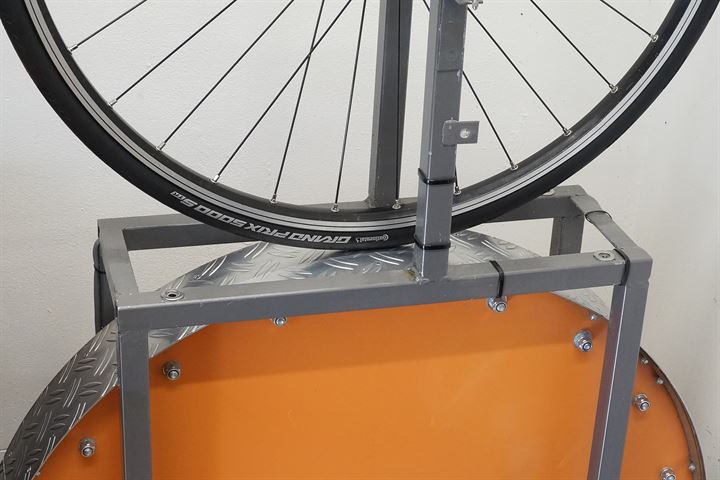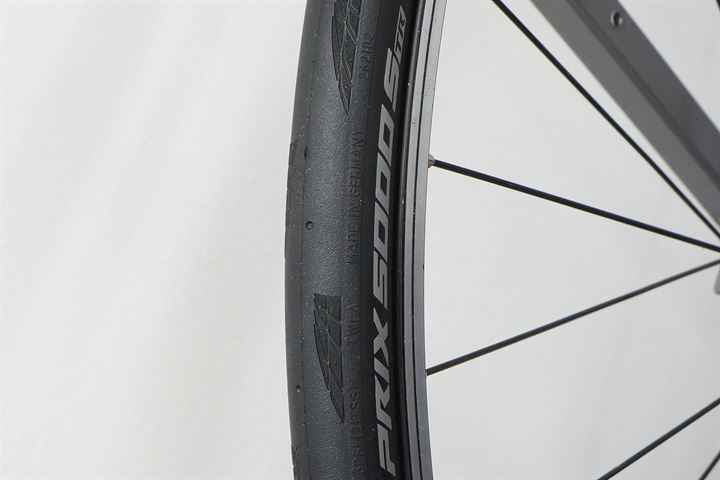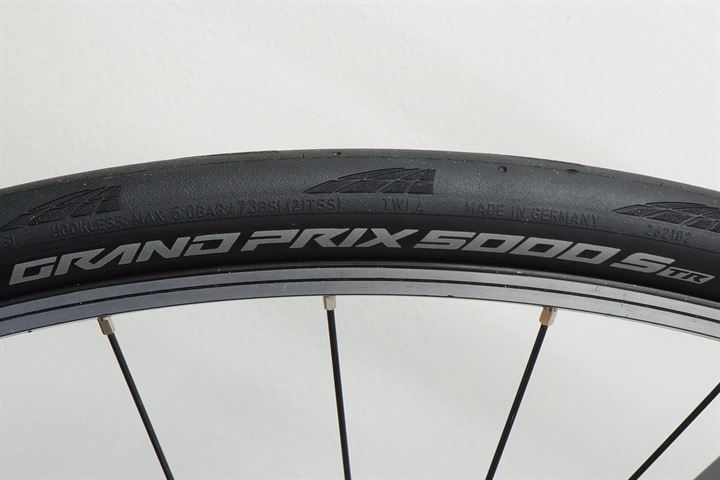Road Bike Tire Test: Continental Grand Prix 5000 S TR 25
Contents and Test Summary
- Introduction
- Manufacturer Specifications
- Size, Weight, Thickness
- Rolling Resistance: 8.4 Watts
- Puncture Resistance: 36 Points
- Static Wet Grip: 66 Points
- Conclusion: 4.6 / 5 Highly Recommended
- Comments
- Continental Grand Prix 5000 S TR 25
(100% is best)

In 2018, Continental introduced the Grand Prix 5000 TL, which was just their first try at a tubeless road bike tire. Performance of the 5000 TL was so strong that it quickly became the most popular tubeless road bike tire. Just three years later, Continental introduced the Grand Prix 5000 S TR and made some significant changes to its design. The Grand Prix 5000 S TR will replace the 5000 TL, and it looks promising as it shaves 50 grams off the 5000 TL in the 25-622 size.
Ad Buy Continental Grand Prix 5000 S TR at Amazon.com
An indication of the popularity of the Continental Grand Prix 5000 series was the rapid rise of the 5000 S TR in our tire voting list, where our Pro Members get a monthly vote and decide which tires will get tested. The Grand Prix 5000 S TR surpassed all other tires, of which some have been on the list for five months, in just eight days of voting. We moved this review forward and worked around the clock to get it on the site as soon as possible.
The outgoing Grand Prix 5000 TL (read our review) was a heavy tire because it was a full tubeless tire that didn't require sealant to hold air. The Grand Prix 5000 S TR isn't a full tubeless tire anymore but, just like almost all other tubeless road bike tires, it's a tubeless-ready (TR) design that requires sealant to seal the tire. Nearly everybody was already running the 5000 TL with sealant as it seals most small punctures, so this shouldn't be much of an issue.
Continental's most significant change was moving from a heavy 3/180 (3 layers 60 TPI) casing to a brand new 2 layer 2/220 (2 layers 110 TPI) design that we haven't seen on any other Continental tire yet. To save even more weight, the 5000 S TR also doesn't come with the additional inner liner made of butyl rubber that worked as an air seal and was the reason why the outgoing 5000 TL technically didn't require sealant.
Although Continental calls the 2/220 casing a 2 layer design, we noticed that it depends on where you count the casing layers. Both the 3/330 (used on the non-tubeless Grand Prix 5000) and 2/220 casing have the same amount of casing material but are folded differently. The 2/220 casing has 2 layers under the tread, and the sidewalls have 3 layers, while the 3/330 casing has 3 layers under the tread, and the sidewalls have only 2 layers. The result is more robust sidewalls, but the tread part will be easier to puncture on the 2/220 casing.
Continental did keep the Vectran anti-puncture breaker under the tread to get the puncture resistance to an acceptable level (see test results). Of course, the Grand Prix 5000 S TR also comes with Continental's Black Chili compound that we've now known for years and is one of the fastest rolling compounds.
Also new, and something we got many questions about lately, is hookless rim compatibility for all sizes of the 5000 S TR. You have to keep an eye on the maximum allowed air pressure when using hookless rims, as this is 73 psi / 5 bars for all sizes.
Continental added the 30-622 and 30-584 sizes which makes the 5000 S TR available in the following sizes: 25-622, 28-622, 30-622, 32-622, 30-584, 32-584.
According to Continental, all these changes combined result in a tire that is 20% faster, 50 grams lighter, 28% stronger sidewalls, and easier tubeless mounting and inflation compared to the older 5000 TL.
We have good news about the last part of that claim as we could get the 5000 S TR onto our rim quite easily and inflated it with a floor pump with the valve core in place, which is a 10/10 on our scale (might be different on other rims). We think part of the trick here is that the casing of the 5000 S TR is stiffer and keeps its shape much better when uninflated. Because of the casing stiffness, the beads are pushed outside when mounted to the rim, resulting in the pre-sealing of the tire.
As usual, we've tested the 25-622 size and put it through all our tests, and compared it to all the latest tubeless road bike tires.
Manufacturer Specifications
| Manufacturer Specifications | |
|---|---|
| Brand | Continental |
| Model | Grand Prix 5000 S TR |
| Year | 2021 |
| Tire Type | Tubeless |
| Supplied By | Bought in store |
| New or Used | New |
| Mileage | 0 km |
| Price Range | Very High |
| Buy At | Ad Amazon.com |
| Manufacturer part number | 0101866 |
| EAN | 4019238054439 |
| TPI | 2/220 |
| Compound | Black Chili |
| Bead | Folding |
| ETRTO | 25-622 |
| Size Inch | 28" |
| Specified Width (mm) | 25 |
| Specified Weight | 250 grams |
| Max Air Pressure (psi) | 109 |
| Made In | Members Only |
| Available Sizes |
25-622 (700x25c) 28-622 (700x28c) 30-622 (700x30c) 32-622 (700x32c) 30-584 (650x30b) 32-584 (650x32b) |
Continental Grand Prix 5000 S TR 25 Test Results

Size, Weight, and Thickness Measurements
| Size, Weight and Thickness Measurements | |
|---|---|
| Specified Weight | 250 grams |
| Measured Weight | 255 grams |
| System Adjusted Weight (tire + valve + rim seal) |
275 grams |
| Measured Width | 26 mm (un-round) |
| Measured Height | 22 mm (un-round) |
| Total Tire Thickness Center | 2.3 mm |
| Total Tire Thickness Sidewall | Members Only |
| Unmounted Casing Width | 64 mm |
| Unmounted Tread Width | Members Only |
| Tread Cover (Tread / Casing Ratio) | Members Only |
| All size measurements are taken at an air pressure of 100 psi / 6.9 bars on a 17.8 mm inner width rim. | |
Rolling Resistance Test Results
| Rolling Resistance Test Results | |
|---|---|
| Inner Tube | None (20 ml sealant) |
| Measured Width | 26 mm (un-round) |
| Rolling Resistance Real tire width in mm: 22-24 = 132 psi/9.1 bar 25-27 = 120 psi/8.3 bar 28-29 = 108 psi/7.4 barUltra High Air Pressure (120 psi / 8.3 bar) |
8.4 Watts CRR: 0.00252 |
| Rolling Resistance Real tire width in mm: 22-24 = 110 psi/7.6bar 25-27 = 100 psi/6.9 bar 28-29 = 90 psi/6.2 barExtra High Air Pressure (100 psi / 6.9 bar) |
9.1 Watts CRR: 0.00273 |
| Rolling Resistance Real tire width in mm: 22-24 = 88 psi/6.1 bar 25-27 = 80 psi/5.5 bar 28-29 = 72 psi/5.0 barHigh Air Pressure (80 psi / 5.5 bar) |
Members Only |
| Rolling Resistance Real tire width in mm: 22-24 = 66 psi/4.6 bar 25-27 = 60 psi/4.1 bar 28-29 = 54 psi/3.7 barMedium Air Pressure (60 psi / 4.1 bar) |
Members Only |
| The Road Bike section is a multi tire size section, air pressures have been adjusted to the measured casing width. All numbers are for a single tire at a speed of 29 km/h / 18 mph and a load of 42.5 kg / 94 lbs. Use the formula: RR (Watts) = CRR * speed (m/s) * load (N) to calculate rolling resistance at a given speed and load. |
|
Puncture Resistance Test Results

| Puncture Resistance Test Results (higher is better) | |
|---|---|
| Total Puncture Score Tread | 36 Points |
| Total Puncture Score Sidewall | Members Only |
| Tread Puncture Force Sharp Needle | Members Only |
| Tread Puncture Force Blunt Needle | Members Only |
| Tread Total Tire Thickness | 2.3 mm |
| Sidewall Puncture Force Sharp Needle | Members Only |
| Sidewall Puncture Force Blunt Needle | Members Only |
| Sidewall Total Tire Thickness | Members Only |
Static Grip Test Results
NOTE: Grip test data is only available on tires tested after November 2018. You can find more information about our grip test here: Introducing Grip Testing
| Static Grip Test Results | |
|---|---|
| Wet Grip Average | 66 Points |
| Wet Grip Center | Members Only |
| Wet Grip Edge | Members Only |
| Grip in points = coefficient of friction * 100 Road bike grip test rim width = 19.0 mm |
|
Conclusion
- Continental Grand Prix 5000 S TR 25
(100% is best)
The Grand Prix 5000 S TR isn't as strong a performer as we initially expected based on Continental's claims. We can't find the claimed 20% reduction in rolling resistance as the 5000 S TR is about equal in our tests when compared to the older 5000 TL (read our review). We're also a bit disappointed to see total tire thickness at the center of the tread has gone down to 2.3 mm from the 2.6 - 2.9 mm we're used to seeing with the Continental 5000 series (and 4000 before that).
The reduction in tire thickness comes from the move to the thinner 110 TPI casing material and the reduction to just 2 casing layers under the tread. The thinner casing means the reduction in tire thickness is on the inside of the tire and the actual rubber tread thickness appears to be roughly the same. This means durability in terms of mileage should be unchanged as there is the same amount of rubber to wear down.
The main problem with changing to just 2 layers of (thinner) casing material under the tread is seen in the puncture resistance tests as the puncture resistance of the tread has gone down by 30% in our test. We'll have to wait for more real-life user experiences about puncture resistance, but the 5000 S TR definitely will be more prone to punctures. A good sealant will be crucial but be aware that sealant will be less effective with less tire thickness as some thickness is required to get fast re-sealing after a puncture.
We only found a reduction of 40 grams of weight when we compare our 2018 5000 TL that came in at 295 grams to our 5000 S TR that comes in at 255 grams. When we examine the weight a bit further, we see the new 5000 S TR is quite a bit smaller for the same size, which further reduces the actual weight savings by about 10-15 grams.
We do see improved sidewall puncture resistance which is a good thing. Initial mounting and inflation were very easy as we were able to inflate it with a floor pump. The sealing of the 5000 S TR was also very good; our sample only lost a couple of psi in the first 30 minutes and held pressure just fine during the tests. The hookless rim compatibility is another welcome addition, as many have held off on the 5000 TL because of this.
Our ultimate conclusion is that the Continental Grand Prix 5000 S TR still is one of the strongest performing (tubeless) road bike tires, but it's become a bit more of a racing tire than an "all-round" tire with the reduced tread thickness and lower puncture resistance of the tread. The most significant improvements can be found in user-friendliness with easy mounting, inflation, and hookless bead compatibility.
Ad Buy Continental Grand Prix 5000 S TR at Amazon.com
RATING:
4.6
/ 5
TEST VERDICT:
Highly Recommended
